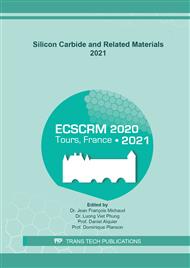p.427
p.435
p.442
p.447
p.452
p.458
p.463
p.468
p.472
Self-Turn-On Phenomenon of SiC MOSFETs by Fast Switching Operation
Abstract:
The effect of the contact resistance between the p-well and the source electrode of SiC metal-oxide-semiconductor field-effect transistors (MOSFETs) on the self-turn-on phenomenon was investigated experimentally. It was found that the contact resistance significantly affects the self-turn-on in addition to the conventional self-turn-on owing to the parasitic capacitances. To simulate this phenomenon, a circuit model including the contact resistance, p-well sheet resistance, and p-well/n+ region diode was created, and the simulation results were compared with the measurement results. Consequently, by considering the contact resistance and the forward recovery effect in the diode characteristics, the gate-induced voltage was calculated, with the results close to those of the experiment. Thus, the influence of contact resistance and p-well/n+ diode effects are clearly very important when operating SiC MOSFETs at high switching speeds.
Info:
Periodical:
Pages:
452-457
Citation:
Online since:
May 2022
Authors:
Keywords:
Permissions:
Share:
Citation:


